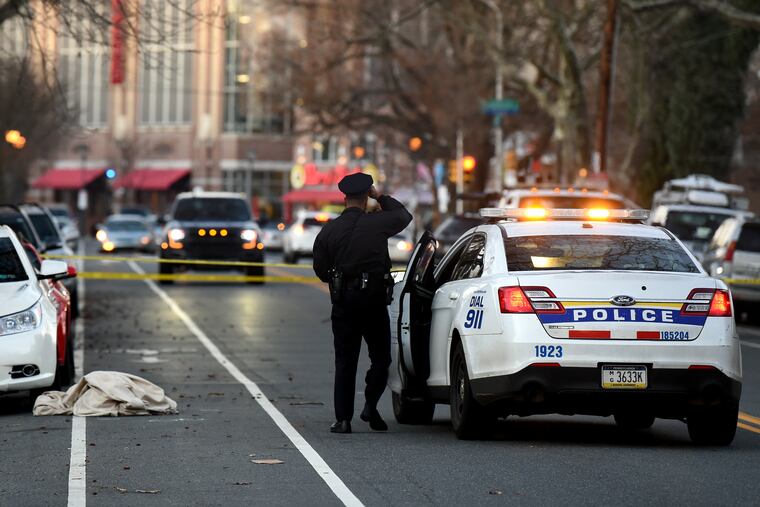Philly deserves more answers on the shiny new plan to stop the shootings | Mike Newall
A version of Focused Deterrence has been sold as a way to curb the killings in Philadelphia. It’s just that no one can say what exactly it will look like.

Here’s the macabre reality of Philadelphia: January is supposed to be the quiet season. A frigid month when the killings ebb. But it’s been anything but quiet here since the beginning of the new decade.
If you count the three people killed on New Year’s Eve, 27 people have been killed in 16 days. Among the dead: A South Philly store owner. A 25-year-old foster mother. A 15-year-old boy.
Someone was stabbed in Center City. A man in Northwest Philadelphia pulled a gun out on a block, aimed at a man holding an 18-month-old child in his arms, and fired anyway. The child suffered a graze wound to his head.
Another few millimeters, and we’d have another dead toddler in Philadelphia. Take that in. Another.
In his inaugural address, Mayor Jim Kenney said his goal was to reduce homicides by 30% by the end of his second term, and cut shootings by a quarter. It’s two weeks into the year. I hate to sound pessimistic. But this is startling carnage, and as more deaths mount, the more lofty those goals feel.
» READ MORE: Kenney’s second term is underway. Here’s what he promises to do in the next four years.
A central part of Kenney’s plan to reach those goals, the city has said, is a return to some version of a program implemented in those heady times not seven years ago, when homicides were plummeting: Focused Deterrence.
Or, as we’re calling it now, group violence intervention. Whatever it’s called, the idea, in its earlier iteration in South Philadelphia in 2013, was to try to reduce shootings and homicides by first identifying the young men — many in neighborhood street crews — who were most likely to shoot or be shot, and flood them with offers of social services. Some models, including our old one, also deployed what can best be described as a hammer of enforcement.
If one gang member in the program ended up pulling a trigger, an array of police and prosecutors would make life difficult for any gang member connected to the triggerman. Surprise probation visits. Enforcing child support payments. Reviving old cases. Upping bail. They would even turn off utilities, if they suspected someone was stealing them.
When it worked, it worked. The program brought about a 35% reduction in shootings.
But the focused deterrence program ended the way things do sometimes in Philadelphia. We lost our focus. And the shootings ticked back up.
The social services — like jobs — fell apart. Or never really got off the ground in the first place. Without real help for the people it was targeting, focused deterrence became not much more than a list of hundreds of young black men in crisis who would get nothing but the full weight of the law on their shoulders.
So focused deterrence — especially the 2013 version — isn’t a cure-all to solve the homicide crisis. But it’s being sold here as a central pillar of our city’s new plan to stop the killings. The shiny new thing.
It’s just that no one can say what the shiny new thing really looks like. Just months away from the launch, we’re still talking in broad strokes rather than stark details, as my colleague Chris Palmer reported. And if any program needs a full accounting of the details, it’s this one, if nothing else to convince understandably skeptical communities that the goal here is save their children’s lives and not just lock them up.
» READ MORE: Philly wants to bring back a version of an old strategy to fight gun violence. Specifics are pending.
What we know is this: The program is planned for West Philadelphia, the aim is to get going by April, and everyone agrees it will lean more heavily on social services this time around.
“The prior iteration of this program overly relied on enforcement, and we’re committed to doing better and having more resources available,” City Managing Director Brian Abernathy said. But, he said, the model will definitely include enforcement. That’s how it’s supposed to work.
I’m skeptical any version of focused deterrence can succeed in a city with so much infighting between departments. Especially now, with District Attorney Larry Krasner and the police so often at each other’s throats. The program can’t work without cooperation. That means cops have to stop blaming Krasner for everything, and Krasner has to commit to a program whose past enforcement protocols seem to clash with his office’s progressive bent.
» READ MORE: Philly FOP boss visits President Trump at White House to criticize DA Larry Krasner
Krasner says he’s in, if at least half of the hundreds of thousands of dollars set aside for focused deterrence will go toward help and resources — the right ones — for the young men it targets. He says he’s also down for stricter enforcement for known shooters and their associates — but not with targeting everyone connected to a shooter.
“We’re not down with guilt by association," he said. “We’re not going to ride roughshod over the Constitution.”
Both Krasner and Abernathy agree the program needs to be fleshed out.
But it needs to get worked out — publicly — now. Because if January is the quiet season, God help us.